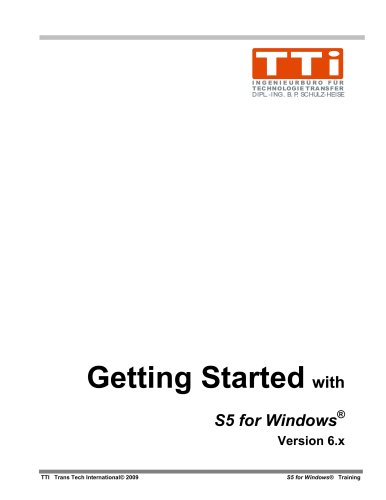
Catalog excerpts
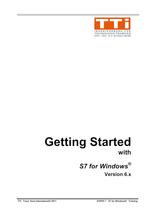
I NGENI E URBÜRO FÜR T EC HNOLOGI E T RA NS FE R DIPL. -I NG. B. P SCHULZ-HEISE . Getting Started with S7 for Windows® Version 6.x TTI Trans Tech International© 2011 STEP® 7 S7 for Windows® Training
Open the catalog to page 1
TTI Ingenieurbüro für Technologie Transfer Dipl. Ing. B. Peter Schulz-Heise Stadtring 207 64720 Michelstadt Tel.: +49 6061 3382 Home page: TTIntl.com Fax: +49 6061 71162 E-Mail: PSH@TTIntl.com Simatic S5, Step 5, Simatic S7, MicroWin, Step 7, Graph5, S7-200, S7-300, S7-400, MPI, DP, PPI and CP are registered trademarks of Siemens Aktiengesellschaft, Berlin und München. . Picture Source: "© Siemens AG 2002, All rights reserved" Windows is a registered trademark of Microsoft Corporation. Excel is a registered trademark of Microsoft Corporation in the United States and other countries....
Open the catalog to page 2
Chapter 1 1 S7 for Windows® Basics Page 1 S7 for Windows® Basics To work with S7 for Windows® basic skills are necessary. 1.1 Opening the S7 for Windows® Software During the installation of S7 for Windows® an icon has been inserted. Double click the icon “S7 for Windows®” to start the programming system. 1.2 S7 for Windows® Basic Window TTI Trans Tech International© 2011 STEP® 7 S7 for Windows® Training
Open the catalog to page 8
Chapter 1 S7 for Windows® Basics Page 2 Title Bar The title bar displays S7 for Windows®, and, if an additional Window is open in the workplace, the name of the open window is also displayed. The Icons are “Windows” specific. Open Control menu This icon opens the Control menu that contains the commands to Restore, Move, Size, Minimize, Maximize, or Close the open Window. The Keyboard shortcut is Alt + Spacebar. Minimizing the open window to an icon Clicking the button at the right side of the S7 for Windows® title reduces the open window to the size of an icon (same function as the Minimize...
Open the catalog to page 9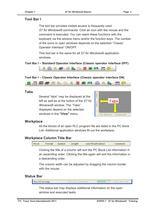
Chapter 1 S7 for Windows® Basics Page 3 Tool Bar I The tool bar provides instant access to frequently used S7 for Windows® commands. Click an icon with the mouse and the command is executed. You can reach these functions with the keyboard via the window menu and/or the function keys. The number of the icons to open windows depends on the selection “Classic Operator Interface” ON/OFF. This tool bar is the same for all S7 for Windows® application windows. Tool Bar I – Standard Operator Interface (Classic operator interface OFF) Tool Bar I – Classic Operator Interface (Classic operator...
Open the catalog to page 10
Chapter 1 S7 for Windows® Basics Page 4 Note: The right mouse button may be used within the Workplace. If the right mouse button is clicked, a menu with the most important commands is opened. 1.3 Operator Interface mode. Version 6.x of S7 for Windows® has a new concept for opening and closing windows in the workplace. Classic Operator Interface If the “Classic operator interface” mode is selected, the “Tool Bar I” is extended and the open windows will stay open until they are closed. To select the previously described mode, click “Classic operator interface” in the “Window” menu. In...
Open the catalog to page 11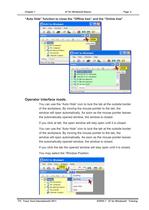
Chapter 1 S7 for Windows® Basics Page 5 “Auto Hide” function to close the “Offline tree” and the “Online tree” Operator Interface mode. You can use the “Auto Hide” icon to lock the tab at the outside border of the workplace. By moving the mouse pointer to the tab, the window will open automatically. As soon as the mouse pointer leaves the automatically opened window, the window is closed. If you click at tab, the open window will stay open until it is closed. You can use the “Auto Hide” icon to lock the tab at the outside border of the workplace. By moving the mouse pointer to the tab, the...
Open the catalog to page 12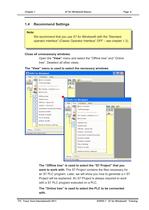
Chapter 1 1.4 S7 for Windows® Basics Page 6 Recommend Settings Note: We recommend that you use S7 for Windows® with the “Standard operator interface” (Classic Operator Interface” OFF – see chapter 1.3). Close all unnecessary windows. Open the “View” menu and select the “Offline tree” and “Online tree”. Deselect all other views. The “View” menu is used to select the necessary windows. The “Offline tree” is used to select the “S7 Project” that you want to work with. The S7 Project contains the files necessary for an S7 PLC program. Later, we will show you how to generate a n S7 Project will...
Open the catalog to page 13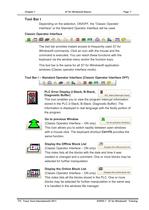
Chapter 1 S7 for Windows® Basics Page 7 Tool Bar I Depending on the selection, ON/OFF, the “Classic Operator Interface” or the Standard Operator Interface will be used. Classic Operator Interface The tool bar provides instant access to frequently used S7 for Windows® commands. Click an icon with the mouse and the command is executed. You can reach these functions with the keyboard via the window menu and/or the function keys. This tool bar is the same for all S7 for Windows® application windows (Classic operator interface mode). Tool Bar I – Standard Operator Interface (Classic Operator...
Open the catalog to page 14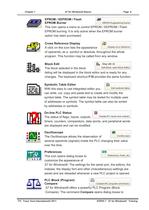
Chapter 1 S7 for Windows® Basics Page 8 EPROM / EEPROM / Flash EPROM Burner This icon opens a menu to control EPROM / EEPROM / Flash EPROM burning. It is only active when the EPROM burner option has been purchased. Cross Reference Display A click on this icon lists the appearance of operands, as a symbol or absolute, throughout the whole program. This function may be called from any window. Block Edit The block selected in the block listing will be displayed in the block editor and is ready for any changes. The keyboard shortcut F10 provides the same function. Symbolic Table Editor With...
Open the catalog to page 15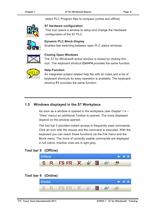
Chapter 1 S7 for Windows® Basics Page 9 select PLC Program files to compare (online and offline). S7 Hardware configuration This icon opens a window to setup and change the Hardware configuration of the S7 PLC. Dynamic PLC Block Display Enables fast switching between open PLC status windows. Closing Open Windows The S7 for Windows® active window is closed by clicking this icon. The keyboard shortcut Ctrl+F4 provides the same function. Help Function An integrated subject related help file with an index and a list of keyboard shortcuts for easy operation is available. The keyboard shortcut F1...
Open the catalog to page 16All IBH Softec catalogs and technical brochures
-
S5 for Windows Getting Started
64 Pages


